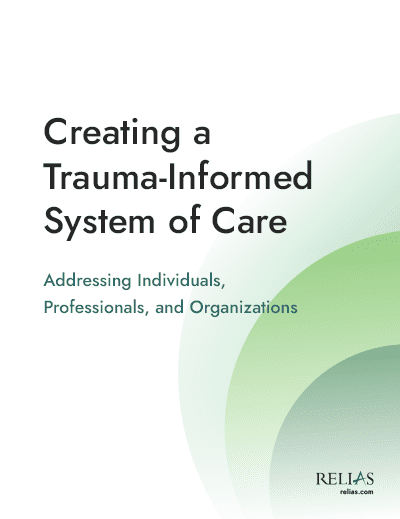Trauma-informed care (TIC) has become a widely recognized paradigm for creating safe spaces for individuals who have experienced trauma, as well as for reducing the likelihood that seeking services would cause re-traumatization. The TIC framework involves recognizing and responding to all types of trauma, as well as acknowledging that trauma reactions are often an individual’s best attempt at coping with traumatic stress. Any organization – schools, behavioral health clinics, community health clinics, disability-serving organizations, and others – can implement and benefit from a trauma-informed system of care.
To help organizations work toward becoming trauma-informed, Relias is excited to announce the launch of a new e-book, “Creating a Trauma-Informed System of Care: Addressing Individuals, Professionals, and Organizations.” This e-book is designed to give a well-rounded view of what trauma-informed care means and how organizations can implement this framework. It also covers topics such as:
- What exactly is trauma and how it affects different populations
- Best practices for addressing trauma with the individuals you serve
- Best practices for addressing trauma in your staff (both clinical and nonclinical)
- How to become a trauma-informed organization, including the key elements of the trauma-informed model of care
Trauma is common and harmful
The prevalence of traumatic stress among the general population is high – 70% of adults have experienced some type of traumatic event at least once in their lives. This can include many different experiences. Surviving a natural disaster, experiencing abuse or sexual assault, first responders arriving at the scene of a crime – all of these experiences (and more) can create a traumatic stress response.
This traumatic stress response can have serious and long-lasting implications. It can evoke a wide range of emotional and cognitive reactions, such as feelings of confusion, exhaustion, depression, and anxiety. It can also lead to poorer physical health outcomes. At its core, traumatic stress can alter the chemical makeup of the brain and cause the body’s nervous system to shift into dysregulation – often causing symptoms such as an increased startle reflex, becoming hypervigilant, or feelings of dissociation.
Recently, the coronavirus pandemic caused several forms of trauma, impacting individuals around the world. Healthcare workers, COVID-19 survivors, and family members and friends of those who died from COVID-19 have all experienced high rates of traumatic stress. This has led to many mental health professionals worried about a second pandemic of mental illness and post-traumatic stress disorder that will linger. Now more than ever, atrauma-informed system of care is needed to address the traumatic impact of the pandemic.
People can move beyond trauma into healing
The TIC framework is incredibly person-centered and focuses on resiliency. It promotes the idea that people who have experienced trauma are not condemned to a life of hopelessness and helplessness. People can, and do, recover from trauma. The conceptual shift away from “What’s wrong with you?” to “What happened to you?” is powerful – the TIC model recognizes trauma responses as normal adaptations to traumatic experiences.
“People who have experienced trauma are not condemned to a life of hopelessness and helplessness. People can, and do, recover from trauma.”
Implementing a trauma-informed approach at an organization often goes hand-in-hand with many other care models and treatment philosophies. It requires a strengths-based perspective common in many human service organizations, as well as a person-centered approach that involves the individual in their treatment and goal-setting. Providers who are trauma-informed are expected to work collaboratively, with everyone on a treatment team working together for the common good of the individual. It also requires relationship-building, incorporating an individual’s cultural background into their treatment, and including the individual in shared decision-making.
The TIC model is not simply for clinicians to practice with their clients – everyone, including administrative staff, peer supports, direct care staff, and supervisors, can (and should) also practice being trauma-informed. In fact, only when the entire organization is involved in the TIC framework, can the organization truly claim that they are trauma-informed. Having all employees at an organization carry a basic knowledge of how trauma affects individuals and how to be trauma-informed in their approach can help improve outcomes for persons served and promote healing.
You can create a trauma-informed system of care
Trauma-informed care is a journey, not a destination. It requires long-term commitment and the ability to consistently re-assess your organization’s efforts. You do not need to do this work alone; let Relias help you work toward your goal of becoming a trauma-informed organization.

Creating a Trauma-Informed System of Care E-book
The experience of trauma has widespread impact on the lives of those you serve. With trauma-informed care, you can address these concerns and create positive outcomes for the individuals you serve, your staff, and your organization.
Download the E-book →





